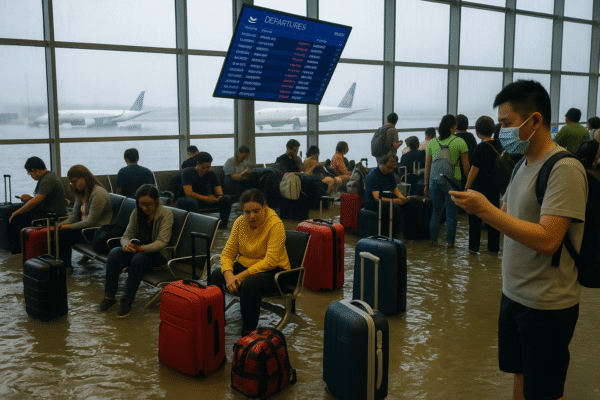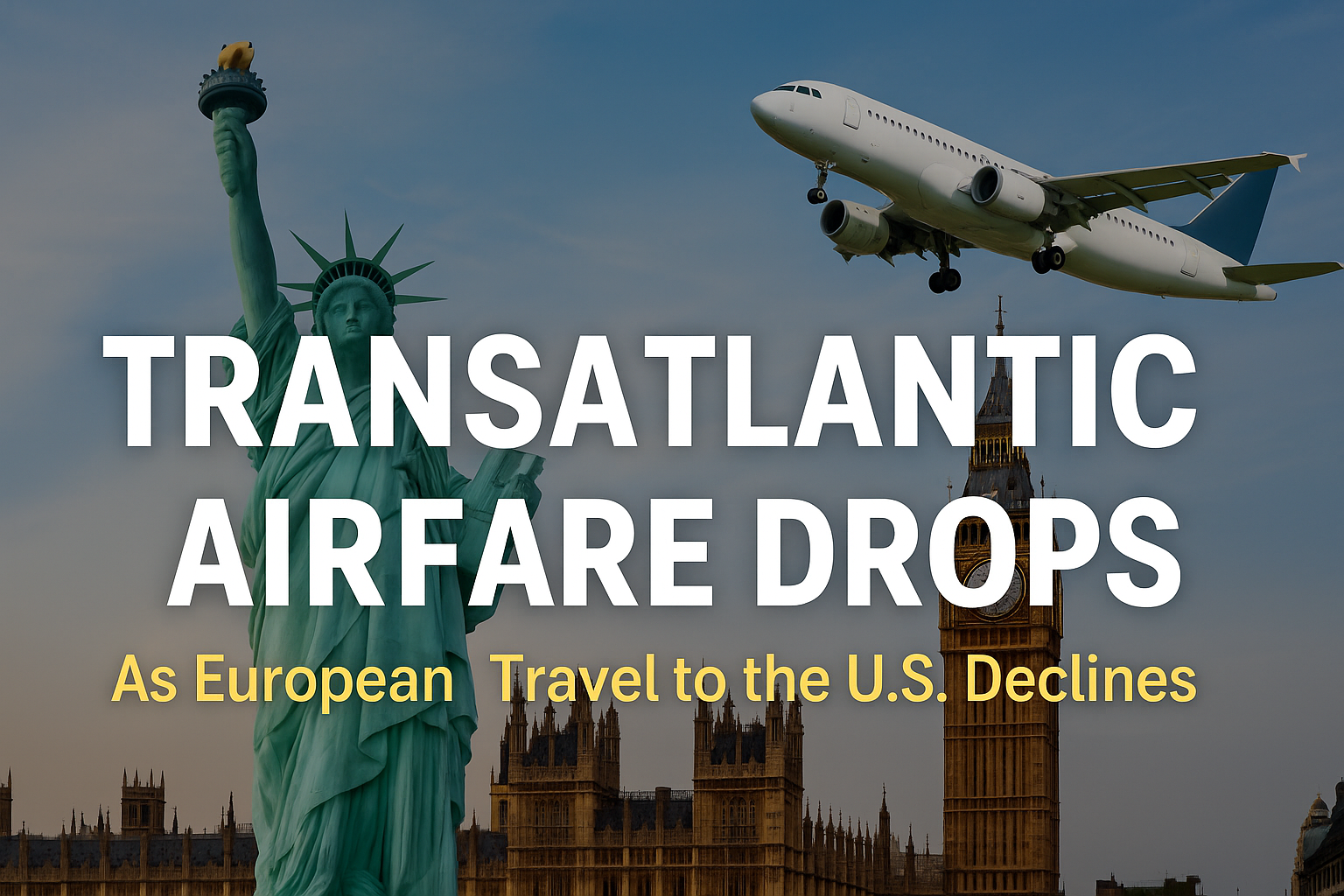June 2025 – Washington, D.C. / Frankfurt / Paris
Transatlantic airfares are dropping to pre-pandemic levels as European travel to the United States slows sharply, reshaping summer 2025 travel dynamics. Fresh data from aviation analytics firms and airline executives confirms a double-digit decline in bookings from Europe to the U.S., forcing airlines to slash prices and adjust strategies during what is typically their most profitable season.
According to OAG Aviation, forward bookings for European travelers heading to the U.S. in July 2025 are down 13% year-over-year, signaling a longer-lasting slump beyond the usual spring lull. The downturn is being driven by a stronger U.S. dollar, political uncertainty, and heightened entry requirements, prompting would-be European tourists to reconsider travel plans.
Airfare Drops Reflect Lower European Demand
Average round-trip fares from the U.S. to Europe have dropped 10% compared to last summer, averaging $817, per travel booking app Hopper. These rates mirror 2019 figures, indicating a return to pre-COVID pricing norms. Meanwhile, Cirium reports a 7% year-on-year drop in economy fares across more than 50 major transatlantic routes in Q1 2025.
Some routes saw even steeper price drops. Atlanta–London, for example, experienced a stunning 55% fare reduction, demonstrating the impact of waning demand from both business and leisure travelers.
NTTO Reports Sharp Drop in European Arrivals
Data from the U.S. National Travel and Tourism Office (NTTO) further confirms the downward trend. In May 2025, total overseas arrivals to the U.S. fell 2.8% compared to May 2024. Travel from Western Europe was particularly affected, declining by 4.4%.
Country-specific figures include:
- Germany: -19%
- Denmark: -20%
- France: -9%
The significant drop in visitors from Germany and France—two of the largest source markets for inbound U.S. tourism—raises red flags for tourism-dependent cities like New York, Miami, San Francisco, and Las Vegas.
Political and Economic Concerns Drive Hesitation
Industry analysts attribute much of the decline to political developments. President Donald Trump’s administration has reintroduced strict border policies, prompting heightened scrutiny at entry points and a cooling effect on tourism sentiment.
High-profile remarks, such as Trump’s revived interest in Greenland, combined with growing global geopolitical tensions, have added to European unease.
Further compounding this is the strong U.S. dollar, which has significantly increased travel costs for Europeans, making American vacations less affordable. Germany’s updated U.S. travel advisory, which now highlights that a visa does not guarantee entry, has also sown uncertainty among travelers.
European Airlines Under Pressure
The slump in demand is impacting European airlines more severely than their U.S. counterparts. Both Lufthansa and Air France-KLM have acknowledged slowing transatlantic demand.
- Lufthansa CEO Carsten Spohr cited weakening trends going into Q3.
- Ben Smith, CEO of Air France KLM, noted a “slight pullback” in long-haul bookings from Europe to the U.S.
Both airlines are cutting fares further to fill seats. However, these discounts come at a time when carriers are already grappling with rising fuel costs, labor disputes, and longer flight paths due to Middle East airspace closures.
U.S. Travelers Help Balance the Books
American carriers like United Airlines, Delta Air Lines, and American Airlines have managed to partially offset the drop in European demand by leaning into outbound U.S. traffic.
- United Airlines reported a 6% decline in Europe-origin bookings, but said strong U.S. outbound demand has helped stabilize earnings.
- Delta Air Lines stated that 80% of long-haul bookings now originate from American travelers, especially to Europe, where demand remains robust despite airfare increases.
This trend has led European airlines to pivot their marketing efforts, targeting affluent U.S. travelers seeking European summer vacations in Italy, Spain, Greece, and Portugal.
Bookings Outlook: More Weakness Ahead
Forward bookings for July 2025 signal that the downward trend will continue. While April saw a brief 12.1% spike in European arrivals—likely tied to the Easter holiday—May’s return to negative territory shows that the market has not recovered.
Even popular events like the Paris 2024 Olympics legacy tourism push and European summer festivals have not been enough to reverse the slowdown.
Meanwhile, outbound travel from the U.S. remains a bright spot. Hopper reports a 4.3% increase in international flights departing from American airports this summer.
Airlines Adjust Strategy for Remainder of 2025
In response to shifting dynamics, airlines are adapting their strategies:
- Lufthansa and Air France KLM are offering bundled discounts and rescheduling some transatlantic flights to optimize capacity.
- U.S. carriers are increasing premium economy offerings and nonstop flights to secondary European cities to capture affluent American leisure travelers.
- Marketing budgets are being redirected from Europe to Latin America and Asia-Pacific, where demand is more stable.
American Airlines CFO Devon May remains optimistic: “We feel really good about the transatlantic market… U.S. travelers are still booking, and we’re adjusting capacity to match.”
Final Thoughts: The Transatlantic Travel Equation is Changing
As Europe-to-U.S. travel dips in 2025, transatlantic airfare has fallen, providing opportunities for American travelers seeking value. But for airlines, especially in Europe, the outlook is complicated by economic headwinds and political uncertainties that may persist through the year.
Tourism officials and airline analysts will closely monitor July and August data to assess whether the dip is a temporary correction or the beginning of a longer-term shift in global travel flows.
For now, if you’re a U.S.-based traveler dreaming of Europe, the skies just got a little cheaper—and a lot less crowded.
For more travel news like this, keep reading Global Travel Wire

















